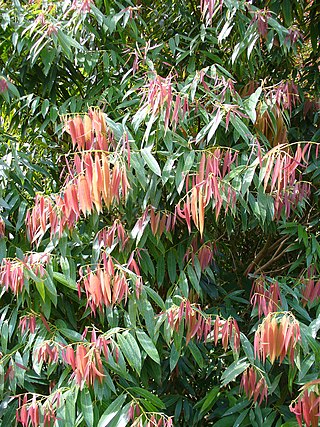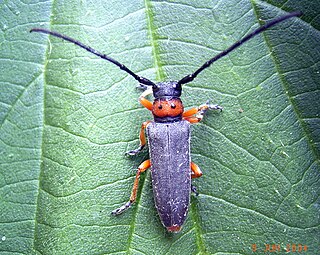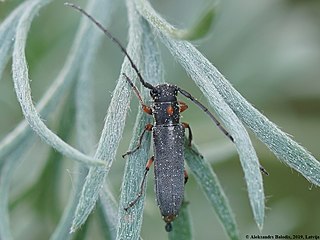Ironwood is a common name for many woods or plants that have a reputation for hardness, or specifically a wood density that is denser than water, although usage of the name ironwood in English may or may not indicate a tree that yields such heavy wood.

Mesua ferrea, the Ceylon ironwood, or cobra saffron, is a species in the family Calophyllaceae native to the Indomalayan realm. This slow-growing tree is named after the heaviness and hardness of its timber. It is widely cultivated as an ornamental for its graceful shape, grayish-green foliage with a beautiful pink to red flush of drooping young leaves, and large, fragrant white flowers. It is the national tree of Sri Lanka, as well as the state tree of Mizoram and state flower of Tripura in India.

Libidibia ferrea, formerly Caesalpinia ferrea, and commonly known as Brazilian ironwood, leopardtree or jucá, is a tree found in Brazil.

Hopea ferrea is a species of tree in the family Dipterocarpaceae. It is native to Cambodia, Laos, Peninsular Malaysia, Thailand, and Vietnam.

Monochroa ferrea is a moth of the family Gelechiidae. It is found from central and northern Europe to the southern Ural. Outside of Europe, it is found in Transbaikalia and the Altai region.

Nagkesar oil is extracted from seeds of the nagkesar tree. It belongs to the Calophyllaceae family. It is an East Indian evergreen tree and is often planted as an ornamental for its fragrant white flowers that yield a perfume. It is the source of hardwood used for railroad ties. It is Sri Lanka's national tree.

Phytoecia is a genus of longhorn beetles of the subfamily Lamiinae,
Phytoecia gianassoi is a species of beetle in the family Cerambycidae. It was described by Sama in 2007 and later reclassified to the subgenus Coptosia within the genus Phytoecia.

Phytoecia puncticollis is a species of beetle in the family Cerambycidae. It was described by Faldermann in 1837. It is known from Russia, Azerbaijan, Georgia, Iraq, Armenia, Turkey, Iran, and Turkmenistan. It feeds on Eryngium billardierei.
Phytoecia gaubilii is a species of beetle in the family Cerambycidae. It was described by Mulsant in 1851. It is known from Tunisia and Algeria.

Phytoecia comes is a species of beetle in the family Cerambycidae. It was described by Henry Walter Bates in 1884. It is known from Taiwan, Myanmar, North Korea, South Korea, China, Vietnam, and Japan.
Phytoecia humeralis is a species of beetle in the family Cerambycidae. It was described by Waltl in 1838, originally under the genus Saperda. It is known from Palestine, Greece, Georgia, Iran, Azerbaijan, Syria, Cyprus, and Turkey. It feeds on Silybum marianum.
Phytoecia millefolii is a species of beetle in the family Cerambycidae. It was described by Adams in 1817, originally under the genus Saperda. It has a wide distribution between Europe and the Middle East.
Phytoecia praetextata is a species of beetle in the family Cerambycidae. It was described by Steven in 1817, originally under the genus Saperda. It is known from Turkey, Bulgaria, Syria, Armenia, Romania, and Ukraine.

Phytoecia affinis is a species of beetle in the family Cerambycidae. It was described by Harrer in 1784, originally under the genus Leptura. It has a wide distribution in Europe.

Phytoecia caerulescens is a species of beetle in the family Cerambycidae. It was described by Scopoli in 1763, originally under the genus Leptura. It has a wide distribution in Europe, and has been introduced into Australia. It feeds on Echium vulgare, Lappula squarrosa, Anchusa officinalis, Lithospermum officinale, and Cynoglossum officinale.

Phytoecia caerulea is a species of beetle in the family Cerambycidae. It was described by Scopoli in 1772, originally under the genus Leptura. It has a wide distribution in Europe.

Phytoecia pustulata is a species of beetle in the family Cerambycidae. It was described by Schrank in 1776, originally under the genus Cerambyx. It has a wide distribution throughout Europe and the Middle East.

Phytoecia rufiventris is a species of beetle in the family Cerambycidae. It was described by Gautier des Cottes in 1870. It is known from Russia, Japan, Taiwan, Mongolia, North Korea, South Korea, China, and Vietnam. It feeds on Artemisia vulgaris.
Phytoecia hirsutula is a species of beetle in the family Cerambycidae. It was described by Frölich in 1793, originally under the genus Saperda. It has a wide distribution between Europe and the Middle East.












